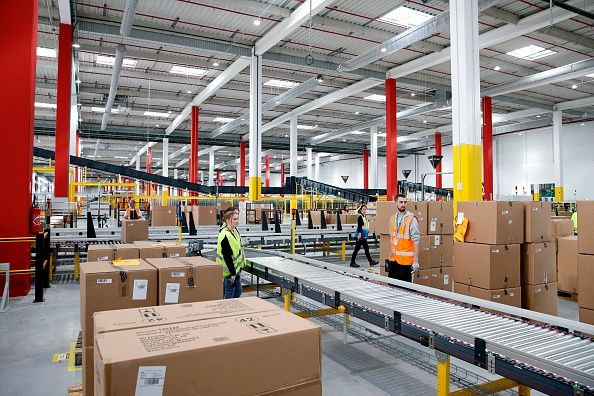Amazon Is Well-Stocked On Seasonal Workers

Amazon (NASDAQ:AMZN) isn't hiring as many seasonal warehouse workers as in years past. The online retail giant is only planning to bring on 100,000 additional employees for the holiday shopping season, compared to 120,000 in 2016 and 2017.
This article originally appeared in the Motley Fool.
The reduction in seasonal hires stands in contrast to Target's (NYSE:TGT) plan to hire 20% more seasonal workers this year: 120,000 total. Citi analyst Mark May suggests that the reduction is due to improved efficiency in Amazon warehouses thanks to robots. While that's true, it might not be the only reason for bringing on fewer seasonal employees.
Extra-tall warehouses
As Amazon builds new warehouses, it's more likely to build up rather than out. This is a trend seen throughout the industry, with the average warehouse growing 21% taller over the last 25 years. The main reason for taller warehouses is increased help from robotic machinery, enabling warehouse owners to maximize the value of the same amount of land.
Amazon is a leader in warehouse robotics, having acquired Kiva Systems in 2012. It has gone on to install over 100,000 of Kiva's big, bright-orange robots in 26 of its fulfillment centers.
While robots can help maximize the use of floor space, the online retailer is fully embracing the idea that floor space isn't everything. "We are debating whether the dynamics of the warehouse are changing so that square footage may not be the main indicator, might be cubic feet," CFO Brian Olsavsky said on the company's third-quarter earnings call last month.
Extra-tall warehouses
As Amazon builds new warehouses, it's more likely to build up rather than out. This is a trend seen throughout the industry, with the average warehouse growing 21% taller over the last 25 years. The main reason for taller warehouses is increased help from robotic machinery, enabling warehouse owners to maximize the value of the same amount of land.
Amazon is a leader in warehouse robotics, having acquired Kiva Systems in 2012. It has gone on to install over 100,000 of Kiva's big, bright-orange robots in 26 of its fulfillment centers.
While robots can help maximize the use of floor space, the online retailer is fully embracing the idea that floor space isn't everything. "We are debating whether the dynamics of the warehouse are changing so that square footage may not be the main indicator, might be cubic feet," CFO Brian Olsavsky said on the company's third-quarter earnings call last month.
Furthermore, Amazon recently increased its minimum wage for employees to $15 per hour. That might disincentivize Amazon from hiring more workers while incentivizing existing employees to take on more hours.
Walmart has found success by offering existing workers additional hours during the holidays instead of bringing on tons of seasonal hires. The company benefits because it doesn't have to spend time and money on hiring and training, and existing workers benefit by picking up more hours.
While the reduction in seasonal workers could be an indication that robots are taking over Amazon's increasingly tall warehouses, it's more likely an economic decision based on the company's recent hiring spree and its new minimum wage. Investors certainly shouldn't see it as an indication of a sales growth slowdown more severe than what the company guided for in its third-quarter earnings release.
John Mackey, CEO of Whole Foods Market, an Amazon subsidiary, is a member of The Motley Fool's board of directors. Adam Levy owns shares of Amazon. The Motley Fool owns shares of and recommends Amazon. The Motley Fool has a disclosure policy.




















